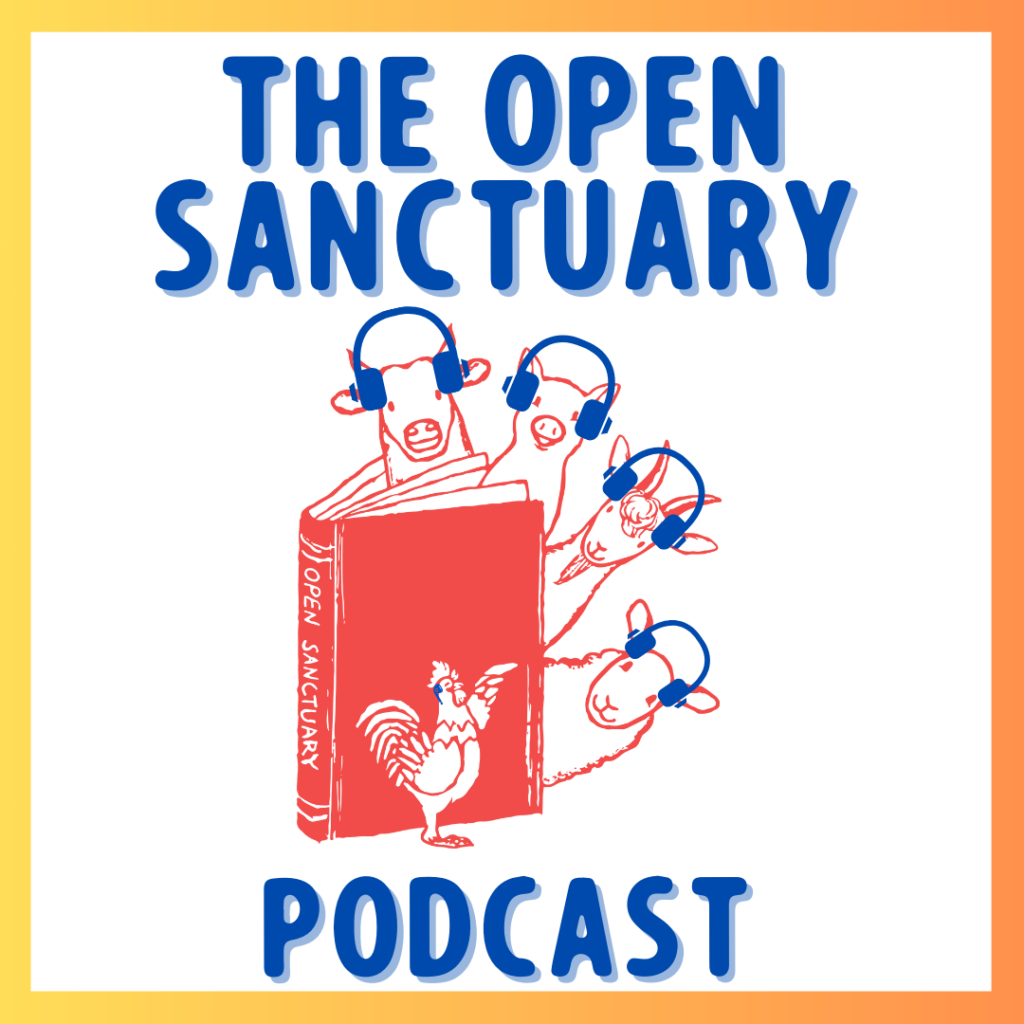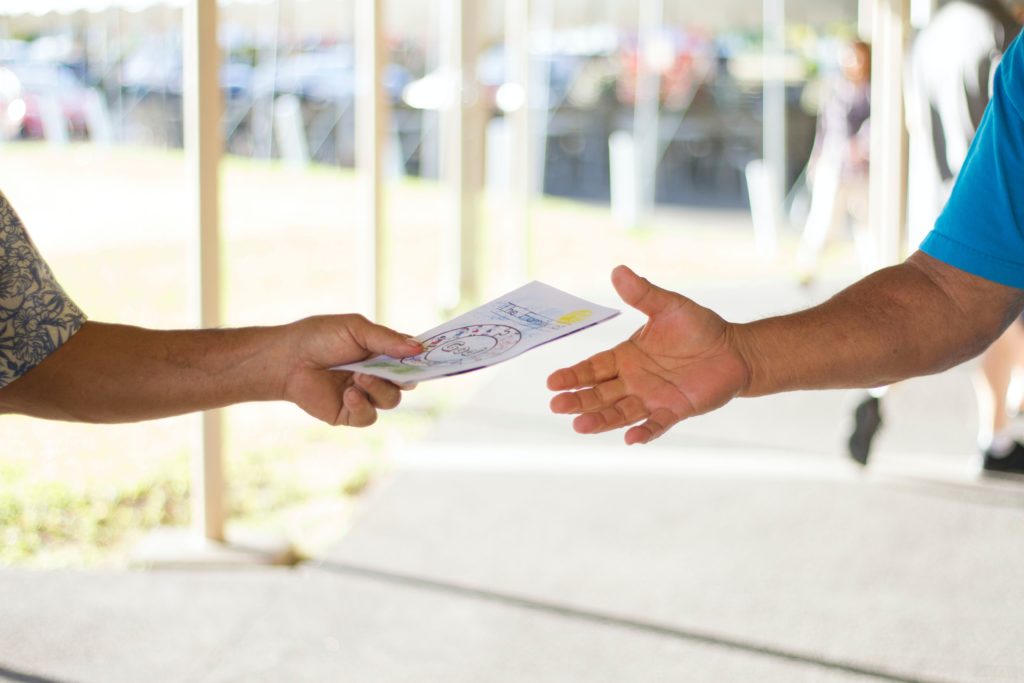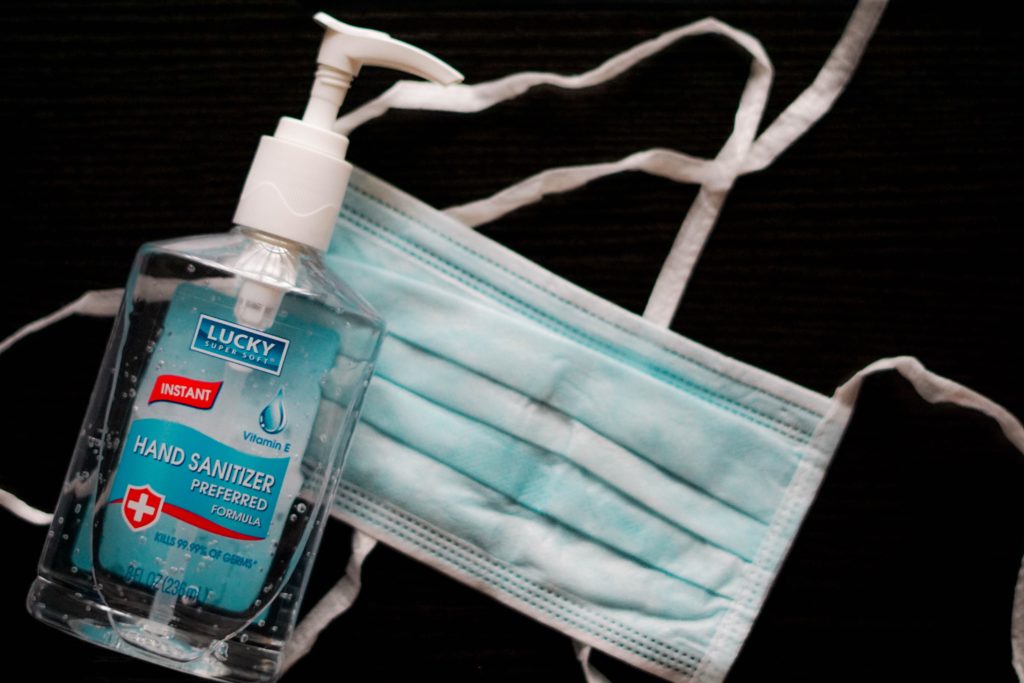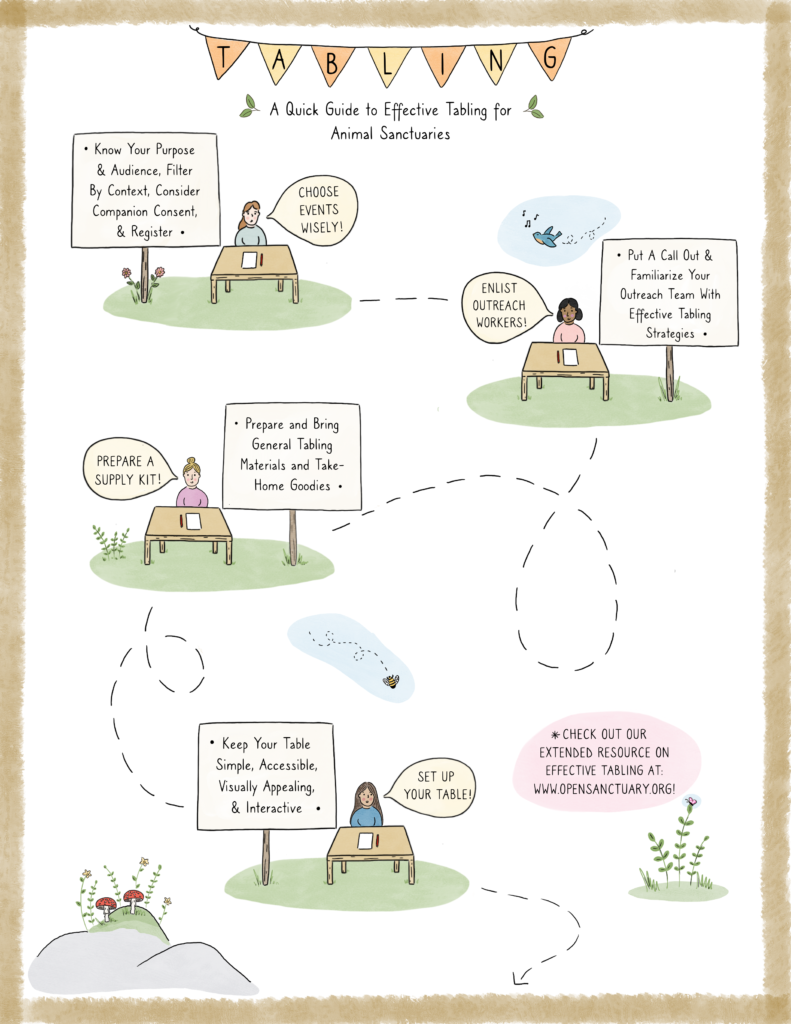

We Have A Podcast Episode On This Subject!
Want to learn about this topic in a different format? Check out our episode of The Open Sanctuary Podcast all about sanctuary tabling tips here!
Introduction
Tabling is a wonderful way for animal sanctuaries to increase their visibility, generate awareness around their mission, engage in conversation with community members, and attract new supporters and volunteers to their organization. Nonetheless, there are a lot of things to carefully consider prior to participating in a tabling event, including location, audience, context, outreachAn activity or campaign to share information with the public or a specific group. Typically used in reference to an organization’s efforts to share their mission. workers, event logistics, supplies, engagement strategy, and more. In this resource, we examine some of the most essential tabling components, strategies, and ideas to help your sanctuary plan and execute a successful and enjoyable tabling experience.
Choosing Events Wisely

Tabling With Intention: Know Your Purpose
If your animal sanctuary is ready to start tabling or wants to table more effectively at outreach events, it can be helpful to ask yourself what your tabling goal or objective is prior to sifting through any potential tabling opportunities. In other words, what specifically would your sanctuary like to accomplish or demonstrate while tabling? For example, your sanctuary community might simply want to raise awareness, spread its message, and share and explain what it does with a wider audience. Or perhaps your sanctuary wants to educate the public about a particular issue related to its work and encourage folks to take some sort of relevant follow-up action, such as sign a petition, reach out to policy makers, or mobilize and brainstorm innovative solutions to related problems in their own communities. Others might want to encourage visits to their sanctuary, recruit new members and volunteers, gain social media followers, and solicit donations. Regardless of which objectives are most relevant to your organization, we recommend focusing on 2-3 of them per event so you can responsibly utilize the resources that are available to you.
Know Your Audience
After you’ve determined why you want to table, the next step is to figure out with whom you want to share these objectives. In other words, who does your sanctuary want to reach out and talk to? Who is your intended audience? Your audience will vary greatly depending on the event you attend, so this is a tabling component you’ll want to consider carefully. For example, if you’d prefer to speak to folks who already understand the concept of a farmed animal sanctuaryAn animal sanctuary that primarily cares for rescued animals that were farmed by humans., then it might make most sense to table at a veganAn individual that seeks to eliminate the exploitation of and cruelty to nonhuman animals as much as possible, including the abstention from elements of animal exploitation in non-food instances when possible and practicable as well. The term vegan can also be used as an adjective to describe a product, organization, or way of living that seeks to eliminate the exploitation of and cruelty to nonhuman animals as much as possible (e.g., vegan cheese, vegan restaurant, etc.). event. However, if you’d like to reach out to folks who are less aware of farmed animal sanctuariesAnimal sanctuaries that primarily care for rescued animals that were farmed by humans., then it might make more sense to table at an event that is not animal liberation-oriented.
Tabling Events for Animal Sanctuaries to Consider
If you’re looking for a place to start searching for potential tabling opportunities, we recommend checking out your local Chamber of Commerce, Department of Parks and Recreation, Tourist Board, and local newspaper(s). These spaces should list any upcoming events in your community including veg fests, farmers markets, agricultural festivals, conferences, plant-based eating events, vegan fairs, vegan arts markets, vegan pop-ups, and more.
Filter by Context
Once you know your tabling objective, have an audience you want to reach, and compile a list of some upcoming tabling opportunities, it’s time to choose an event(s) that’s most relevant to your sanctuary. As you filter through your options, consider these additional contextual questions to help guide your decision:
- Who is the event organizer?
- When is the event?
- Does the event timing work within your sanctuary’s scheduling capacity right now?
- Do you have time to recruit volunteers or staff to table at this event?
- Where is the event?
- Do you have access to appropriate transportation to get to this event?
- Do you want to bring any nonhuman animal companions to this event? If you are considering this, is this event space a safe place to bring nonhuman animal companions?
- How much does it cost to table at this event?
- Are there registration fees?
- Will the event provide tables, chairs, food, water, etc. for you?
- Is the total cost of tabling at this event within your sanctuary’s financial capacity right now?
Create Your Own Tabling Opportunities!
If offsite tabling events are just not feasible for your sanctuary right now or you’d simply like to create more opportunities, it’s always a good idea to set up a table or two at the events that your own organization hosts each year!
Nonhuman Animal Companions and Consent
Allowing folks to observe and/or interact with animal companions outside of their sanctuary space should only be done after carefully considering the issue of consent and the issues and needs of each individual. For some animal companions, it’s very clear that they are comfortable being taken out of their home, and for others, it’s very clear that they are not. The same consideration of consent should also be made with regards to animal companions and interaction with humans. For some individuals, it’s very clear that they enjoy interacting with humans, and for others, it’s very clear that they do not. Some might thoroughly enjoy interacting with humans for a little while and then become tired of it. Others might be comfortable interacting with humans, but uncomfortable being taken away from their home. Regardless, it’s important to remember that sanctuaries are not petting zoos and it is critical that we respect the autonomyThe ability for individuals to have access to free movement, appropriate food, and the ability to reasonably avoid situations they wish to avoid. and space of our companions to the greatest extent possible. If you are considering bringing one of your nonhuman animal companions to a tabling event because they enjoy being taken away from their home and interacting with humans, it is imperative that you take all the necessary steps to ensure the event setting is comfortable and safe for them prior to bringing them there. Here are some initial questions to help guide your thinking around this decision:
- Is the event going to be held inside or outside?
- Will other nonhuman animals be there?
- Will there be other nonhuman animals there that may cause unnecessary stress to your nonhuman animal companions?
- Is there a health code that might prohibit or make it unsafe to bring a nonhuman animal companion?
- Will the event and audience, in general, be respectful of your nonhuman animal companion’s space?
- How will you ensure the physical and mental safety at all times of your nonhuman animal companions at this event?
- Will there be a quiet space for animal companions who have had enough, as well as someone to watch over them while they are taking a break in this space?
- What will you do if your animal companion decides they’ve had enough before the event is over and just really needs to go home?
A Word of Caution
Extra careful consideration needs to be made for animals that are at any increased risk of stress, illness, or injury, including already sick or injured animals, babies, and elderly companions. We would advise against bringing any of these particularly vulnerable individuals outside of their homes and allowing them to interact with human visitors to ensure their safety and the safety of humans. As a general guiding principle, if you feel the slightest bit concerned for an animal’s physical or mental well-being and safety, then you should not allow them to be handled or taken away from their home with the exception of healthcare purposes.
Check Back In!
The Open Sanctuary Project is in the process of developing a resource that will take a much deeper dive into the issue of consent and respectful human-animal interaction, so please check back in! In the meantime, if you have thoughts about this issue that you’d like to share with us, feel free to get in touch with us here.
Register!
Once you’ve chosen an event you’d like to table at, you should reach out to the event’s organizer and ask if you can participate. If you are invited to join multiple events, prioritize the tabling opportunities that align the most with your sanctuary’s missionThe stated goals and activities of an organization. An animal sanctuary’s mission is commonly focused on objectives such as animal rescue and public advocacy., outreach objectives, and resource capabilities.
Outreach Workers

Outreach workers are people who represent your organization and its message in public spaces like tabling events, so it’s imperative that you choose folks to table who are adequately prepared and committed to engage comfortably and positively with members of the community regarding your organization and the issues related to your work. While there is no “one size fits all” type of outreach worker, there are some general qualities, skills, and other things to look for and equip them with that will increase their chances of successfully representing your sanctuary at a tabling event.
Put a Call Out for Outreach Workers
In order to appoint the most appropriate and effective outreach workers for your sanctuary, it’s important that you first determine what kind of specific support you’ll need at the tabling event(s). For example, how many folks from your sanctuary would you like to send? It’s generally more fun and more manageable to have at least two people tabling together, so it’s good to consider enlisting the help of at least two folks who work well together for each event! Additionally, do you want to enlist help from within your current staff or volunteer pool? Or do you want to enlist an entirely new staff person or volunteer for this role? If so, how far in advance will you need to put a call out for outreach workers?
When you’re ready to put the call out, it’s really important that you provide any potential candidates with all the necessary background information on the tabling event, including your sanctuary’s outreach goals and objectives. It’s also important that you discuss the candidates’ prior community outreach experiences and clarify your expectations of their role, such as how many total hours of work will be expected of them, what level of responsibility they will have, and what you want them to accomplish at these events. Find out what kinds of tabling strategies they currently employ at outreach events and determine whether these strategies and techniques are appropriate for your organization. Do you have the time commitment and capacity to train them appropriately in these areas if necessary? Will the outreach worker(s) need to develop any written materials, graphic aids, or other tools, as well as any written summary or reflection following the tabling event(s)?
What Makes an Effective Outreach Worker at Tabling Events?
Tabling is an inherently social activity since the ultimate goal is to engage members of the public in conversation about your organization as much as possible, so it’s imperative that your outreach workers are familiar with effective tabling techniques and have excellent communication skills. This includes, but is not limited to, the ability to begin and carry a conversation comfortably, listen well, accept diverse perspectives, remain patient, maintain an open and respectful attitude, and adhere to your organization’s specific messaging protocol. Effective outreach workers should also have the ability to give basic information about your sanctuary, including when and where it was founded, its mission and vision, what types of action it takes, and how community members can get more involved. They should be able to speak accurately about the specific issues you want to present while tabling and explain why they are important, know the answers to common questions related to those issues, and be able to refer folks to other resources or follow up with them later if they do not currently know the answers to those questions.
What to Bring

On the day of tabling, outreach workers will be utilizing a variety of materials and supplies to effectively engage with members of the community. While some of these materials will vary depending on each individual organization and event, there are a number of general supplies that we recommend every sanctuary prepare in advance and have on hand at their table on the day of the outreach event. We also include a list of optional take-home goodies for you to consider offering. In addition to helping you attract more folks to your table, take-home goodies are a fun way to encourage folks to remember your organization and the conversation they had with your outreach workers. If you decide to offer take-home goodies and have a little extra financial bandwidth in your outreach budget, we recommend having them imprinted with your sanctuary’s name and logo.
General Materials and Supplies
- Table(s) and folding chairs. Some events will provide these, but you may need or want to bring your own. Ask the event organizer what’s possible and available ahead of time.
- Tablecloth. Some venues will provide tablecloths, but you might want to bring your own depending on how you’d like to decorate your table. If the event is outside and the weather is inappropriate (windy or rainy), we recommend skipping this item.
- Tent or canopy, depending on weather and resource capability
- Paperweights in case of wind and heavy bricks to anchor a tent or canopy if you’re using one
- Large banner or poster with your organization’s name and logo clearly displayed so passersby know which organization your outreach workers represent. Consider setting these up either above and behind your table, hanging from the front, or both.
- Bungee cords for banners. We recommend practicing your setup with these in advance.
- Other visual displays that clearly and simply communicate your sanctuary’s message. Think big pictures and big words, and limit the amount of text on your displays.
- A spool of nylon cord for tie-downs and other needs
- Comfort items for your outreach workers such as food, water, sunscreen, and blankets, depending on the event space and weather.
- Name tags for your outreach workers
- Notepad for taking notes on important conversations you’ve had and want to follow up on later
- Pens, highlighters, tape, rubber bands, paper clips, stapler, scissors
- Hand sanitizer and face mask
- Business cards that include your sanctuary’s contact information
- Paper and/or electronic sign-up sheets for folks who are interested in learning more about or joining your organization. Sign-up sheets should always include columns for name, phone number and email address. Additional columns might include “Keep me informed about [specific issue]” or “I’d like to get involved/become a member”. If you’re using paper sign-up sheets, attach them to a clipboard to keep them organized and accessible. You might also want to consider providing additional clipboards with sign-up sheets in case your table gets busy! We recommend orienting the sheet horizontally in landscape format with your sanctuary’s name and logo clearly displayed at the top, and clearly indicated spaces where folks can fill in their information below. If you’d like to make this an electronic sign-up process, you can use a laptop or tablet computer with a simple spreadsheet or online form.
- Binders with resident stories and information in them
- Donation box if your organization wants to fundraise
- Scannable QR codes for merchandise and donations. These should link via phone to your organization’s shop and/or donation site.
- A way to cover things up in case it rains such as a shower curtain with clips or a sturdy container to store and secure all of your important tabling materials and supplies
Optional Take-Home Goodies
- Pens and pencils
- Stickers
- Bookmarks
- Magnets
- Buttons
- Resident trading cards
- Candy
- Newsletters
- Brochures
- Care guides
- Relevant resources from The Open Sanctuary Project
- Business cards with your sanctuary’s social media tags and QR codes that link to your sanctuary’s merchandise and/or fundraisers
- Other relevant literature
Other Optional Supplies to Make Visits to Your Table Extra Fun!
- Quizzes
- Photo booths
- Games, raffles, and spin wheels with prizes (e.g., signed book or t-shirt)
- Colored lights or a spotlight to draw attention
Sign-Up Sheet Download
Enter either your organization’s name or your name and email below to download a printable sign-up sheet template for your animal sanctuary’s next tabling event! We promise not to use your email for any marketing purposes.
Would you prefer to access this form in a different way? Contact us and let us know!
Set-Up
Whether the event is going to be inside or outside, it’s important to keep your set-up process as simple and stress-free as possible. You can achieve this by planning ahead! First, take inventory of all the materials and supplies you’ll be bringing to the event. If you’re bringing a lot of large equipment (e.g., your own tables, chairs, tents, banners, etc.), consider practicing setting these things up in advance of the event so you’ll know what time you should arrive. Once you’ve arrived at the event and set up the larger equipment, it’s important to design your table to be as accessible, visually appealing, and interactive as possible. We recommend keeping the table tidy by removing any personal items (e.g., cell phones, water bottles, coffee cups) and making sure that everything is neatly organized and displayed. Consider designating a specific area on your table where folks can help themselves to general information about your sanctuary, such as business cards, brochures, and take-home goodies, as well as another area where folks can access your sign-up sheets and/or check out a binder with photos of your residents. We recommend fanning out your literature in a straight row, not in a semicircle, to make it as readable and accessible to passersby as possible. You should also be mindful not to put too many items on your table, as this can be overwhelming and intimidating for some folks. If you use a large-enough tablecloth, you can put everything that you’d like to remain unseen underneath your table.
Community Engagement: How to Comfortably and Positively Connect with the Public at Your Table

Initiate a Conversation with Passersby
Although tabling is a wonderful opportunity for sanctuaries to engage with a wider public audience, striking up conversations with strangers to talk about your work can sometimes be a little bit of an intimidating task. One of the most effective ways to begin this process is by remaining as friendly and approachable as possible. You can accomplish this in a myriad of ways. First, move yourself from behind the table and towards passersby. Then, establish eye contact with your audience, smile, and say “hello!”. If someone is visibly uninterested, simply say “Enjoy your day!” and let them go. If someone is visibly interested and says “hello” back, you can ask them if they’ve heard of your sanctuary before. If they have, this is a great opportunity to invite them to come closer to your table, share some of what they know about your group, and take action. “Actions” should be relevant to your sanctuary’s mission and work, appropriate for the audience and community in which you are tabling, and quick and easy for passersby (e.g., sign a petition, join your organization, enter a raffle, etc.). If they have not heard of your sanctuary before, you can say, “I’d love to chat with you for a few minutes about our work if you’re interested?”. If they say, “yes”, say “Wonderful! I’d love to tell you more about us!”
Things to Avoid If You’re Trying to Attract Folks to Your Table
• Avoid looking down at your phone. Folks are much less likely to stop by your table, ask questions, and take your information if you are constantly checking your phone. We recommend putting your phone away and keeping it on silent to avoid as many distractions as possible.
• Avoid wearing shirts or displaying signs with messages that are patronizing or denigrating in any way. These will drastically lessen the likelihood that folks stop by to chat with you.
• Tabling in pairs can be a lot of fun since you have someone to talk to and feel less intimidated to reach out to passersby. However, it’s important to make sure you’re not ignoring folks who are walking by or intimidating them while you’re conversing with one another.
The Elevator Pitch
Once you’ve struck up a conversation with someone who is interested in learning more about your work, this is the time to give them your elevator pitch. We recommend creating and practicing an elevator pitch before you go to an event so you can confidently move forward in your engagement process. It should be quick, relevant, and appropriate for the event’s audience. For example, your elevator pitch could consist of a brief explanation of your sanctuary’s history, mission and vision, what types of action it takes, as well as a few different ways folks can get more involved with your work. This could include encouraging folks to sign up for your mailing list or newsletter, inviting them to any upcoming events, and more. You should also have any relevant literature and ways to contact you on hand, including brochures, business cards, flyers, bookmarks, or other take-home goodies, and try to ensure that everyone who stops by your table leaves with one of your resources. Just make sure you are familiar with your table’s literature and resources so you know where to guide folks and what to give them.
Continuing the Conversation
While it’s important to try and connect with multiple people at a tabling event, it’s also important to take time to chat a little longer than usual with folks who really want to continue a positive conversation with you about your work. Here are some ways to continue a positive conversation:
Show Interest
Actively listen to your audience members, their views, and their experiences with your organization or animal-related issues. Perhaps you’d like to ask interested folks some key questions related to your work. If so, try and determine these ahead of time so you can facilitate the most fruitful conversations, help your sanctuary move towards its objective, and make the most impact while tabling.
Be Authentic
Always try to represent your sanctuary and yourself in an honest and sincere way. If someone asks a question that you don’t know the answer to, it’s okay to say you don’t know. Being untruthful about statistics or facts just to prove a point is misleading and harmful for your organization, and potentially could also be harmful to the animal liberationA social movement dedicated to the freeing of nonhuman animals from exploitation and harm caused by humans. movement and farmed animalsA species or specific breed of animal that is raised by humans for the use of their bodies or what comes from their bodies.. Similarly, if you have opinions that differ from the sanctuary you are tabling for, tell your audience that they are your own opinions and do not necessarily represent the position of your organization.
Be Respectful
Some folks are likely going to want to dig into a sanctuary or animal-related issue a little deeper with you. If the issue is something you disagree on, take this as an opportunity to practice civil discourse, create a space that encourages openness, and develop a deeper understanding of one another’s perspectives. Reflect your understanding of your audience’s words, attempt to clarify, and acknowledge their valid points. This can reduce the likelihood of conflict, help you establish common ground, and build the foundation for a potentially ongoing positive relationship. A progression of dialogue that builds from mutual respect can also lead to possible solutions and action steps for issues that are important to you both.
End On a Positive Note

Always try to end a tabling engagement on a positive note by offering your audience some of your resources and take-home goodies, smiling, and thanking them for stopping by.
Addressing Hostility
Tablers should always be prepared for the possibility of coming across an audience member who is actively hostile and against what your organization does. If someone is rude to you and wants to argue, remain respectful and politely let them know you have to move on to someone more positive and receptive to your message. If they continue to argue and treat you unkindly, disengage entirely and ask for help from the event organizer. If someone is just confused by your presence at a particular event (e.g., a farmer’s market selling local flesh), be clear that your sanctuary is not endorsing or negating the ideas or opinions promoted by the event but simply supporting discussion around the topic of farmed animals.
Things to Avoid While Engaging in Deeper Conversation with Your Audience
• Try not to overly complicate conversations around sanctuary and farmed animal-related issues with complex, inaccessible, overly academic, or philosophical jargon. Instead, try to remain specific and use clear illustrative language whenever you can.
• Keep distressing information and imagery to a minimum. Too much of this can overwhelm folks and cause them to disengage from meaningful conversation.
• Do not patronize, stereotype, or denigrate anyone. This will greatly undermine your sanctuary’s outreach efforts.
Tabling and Outreach Scripts for Sanctuaries
Having scripts at hand can be really helpful for people who are new to your sanctuary, veganismA movement and way of living that seeks to eliminate the exploitation of and cruelty to nonhuman animals as much as possible. Often, veganism is defined synonymously with a plant-based diet, although veganism includes abstaining from elements of animal exploitation in non-food instances when possible and practicable as well., tabling, or outreach more generally. For example, your team could create a script for your outreach workers with scenarios and conversations they will likely encounter at a tabling event so they can prepare and practice with one another ahead of time. Our team at the Open Sanctuary Project also created a starter guide to common questions sanctuaries get asked and how to thoughtfully answer them to help make outreach tasks like these a little more manageable for sanctuary representatives, outreach workers, and educators. If you’d like to take a look and potentially utilize this guide for a tabling event, please click here.
Troubleshooting

While we certainly hope all of your tabling endeavors go off without a hitch, we highly recommend preparing for potential issues in advance. Anticipating roadblocks will allow you to remain flexible and recover from challenges much more manageably. You can begin to prepare for potential issues by contacting the event organizer(s) and asking if they have any specific tabling guidelines they’d like you to follow, such as check-in, check-out, what you can or cannot bring, do, or offer at your table, how much space you will be given, and so forth. You should also ask them in advance for an official point of contact who will update you on any potential schedule changes.
Other potential roadblocks to anticipate include inclement weather, vehicle trouble, and technology mishaps. In the event that inclement weather or vehicle trouble impacts your ability to get to an event, it’s important to ask the event organizer ahead of time if you can get refunded for any sort of deposit you may have placed. You might also consider having an alternative mode of transportation in place should your vehicle break down or become inaccessible. In the event that inclement weather does not impact your travel, but does affect a tabling opportunity that is supposed to be outdoors, it’s important to ask the event organizer ahead of time if there is an alternative indoor space for folks to utilize. If there is, your team should be prepared to move all of your equipment into this space. This might mean bringing a hand truck or two to help make this process easier. If there is not an alternative indoor space to move to, and the event continues, carefully look over your equipment ahead of time and anticipate adjustments. For example, if high winds are expected to impact an outdoor event, you might want to reconsider utilizing a canopy tent.
Additionally, if you are relying on technology for any part of your tabling presentation, make sure you have backup technology in place in case it breaks down or fails. This might include preparing a digital presentation as well as one on paper.
Breakdown
As with setup, so with breakdown. You can keep your breakdown process as simple and stress-free as possible by planning ahead for that, too! If you’ve already practiced setting up your larger equipment, you should also practice breaking it down. This way, you’ll know how much time you’ll need to put everything away after the event ends. With that said, make sure you know what time the event ends ahead of time, so you know when you need to start breaking your equipment down to get out of there on time. Whether you have one or more outreach workers representing your sanctuary at an event, it’s important to know in advance if they’ll need additional help packing up and/or transporting equipment back to their vehicle or another mode of transportation so you can plan accordingly. We also recommend having sturdy containers to put everything back in an orderly and secure fashion, so that you’ll already be somewhat organized and prepared for your next tabling event!
Evaluation and Follow-Up

Although all tabling events eventually come to an end, community engagement processes do not! In fact, what you do after a tabling event ends is one of the most critical components of effective outreach! One vital component of effective outreach that sanctuary leaders and outreach workers should consider after a tabling event has ended is follow-up and ongoing communication with community members that stopped by and connected with you. For starters, you should input all contact information you receive on your sign-up sheets into an organizational outreach database and then reach out to those contacts within one to two weeks after an event has ended. This is a great opportunity to thank them for stopping by, invite them to an upcoming event at your sanctuary, and answer any questions you may have been unable to address at your table. If you have folks sign petitions at your table, this is also the time to ensure those signatures reach your intended target.
Your sanctuary’s outreach workers and leaders should also always come together after an event to debrief and reflect on what strategies worked well and what strategies did not work well. To help make this process as effective as possible, we highly recommend that you conduct some kind of formal or informal post-engagement evaluation. In addition to helping you improve future tabling opportunities, results from an evaluation process can also be used to secure continued organizational funding and support for your outreach endeavors.
A Quick Guide to Effective Tabling
In our efforts to summarize this extended resource and make the tabling process more manageable for your sanctuary’s outreach team, we’ve put together a fun two-page quick guide to effective tabling that is downloadable and printable. Enter either your organization’s name or your name and email below to receive your very own copy. We promise not to use your email for any marketing purposes.
Would you prefer to access this form in a different way? Contact us and let us know!


Sources:
Accessibility for Deaf and Hard of Hearing Community Members at Your Animal Sanctuary | The Open Sanctuary Project
Act, Strategies, Community Engagement | Racial Equity Tools
A Starter Guide to Common Questions Your Sanctuary Gets Asked and How to Thoughtfully Respond to Them | The Open Sanctuary Project
Dialogue to Change Process | Organizing Engagement
Education Program Evaluation for Animal Sanctuaries | The Open Sanctuary Project
Engagement Streams Framework | Organizing EngagementA
Facilitation Guide for Community Engagement | Asian Americans/Pacific Islanders in Philanthropy
Guide to Effective Tabling | Compassionate Action for Animals
Guide to Leafleting at MFA | Mercy For Animals
How to Table an Event | Death with Dignity
Practical Biosecurity Measures for Animal Sanctuaries | The Open Sanctuary Project
Practical Guide to Tabling | Amnesty International
Principles | Organizing Engagement
The Complete Guide to Tabling | Amnesty International
The Differences Between an Animal Sanctuary and a Petting Zoo | The Open Sanctuary Project








